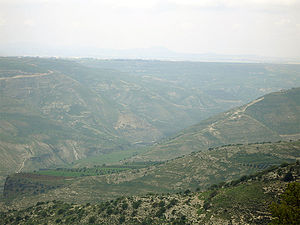| Battle of Yarmouk | |||||||||
|---|---|---|---|---|---|---|---|---|---|
| Part of the Muslim conquest of Syria and Byzantine-Arab Wars | |||||||||
 Across the ravines lies battlefield of Yarmouk, a picture taken 8 miles from battlefield, from Jordan. | |||||||||
| |||||||||
| Belligerents | |||||||||
|
Byzantine Empire, Ghassanid Kingdom, |
Rashidun Caliphate (Rashidun army) | ||||||||
| Commanders and leaders | |||||||||
|
Heraclius † Theodore Trithyrius[1] † Vahan[1][2] Jabalah ibn al-Aiham † Dairjan[3] Buccinator (Qanateer)[3] Gregory[3] |
Khalid ibn al-Walid Abu Ubaidah ibn al-Jarrah Amr ibn al-A'as Shurahbil ibn Hassana Yazid ibn Abu Sufyan | ||||||||
| Strength | |||||||||
|
80,000 - 100,000 (primary sources)[5][6] |
25,000 - 40,000 (primary sources)[8] | ||||||||
| Casualties and losses | |||||||||
|
50,000 killed 70,000 - 120,000 killed (primary sources)[10] | 4,000 killed[3] | ||||||||
The Battle of Yarmouk (Arabic: معركة اليرموك, also spelled Yarmuk, Yarmuq or Hieromyax) comprised a series of engagements between the Rashidun Caliphate and the Byzantine Empire over six days in August 636, near the Yarmouk River, along what is today the border between Syria and Jordan, south-east of the Sea of Galilee. The battle marked the first great wave of Islamic conquests after the death of Muhammad, heralding the rapid advance of Islam into the then Christian Levant. The battle is also considered to be one of Khalid ibn al-Walid's most decisive victories, and cemented his reputation as a great tactician and cavalry commander.[11]
- ^ a b Kennedy, Hugh N. (2006). The Byzantine and Early Islamic Near East. Ashgate Publishing. p. 145. ISBN 0754659097.
- ^ Vahan is known as Mahan in certain Muslim texts although most scholars use Vahan only.
- ^ a b c d e Akram 2004
- ^ Modern estimates for Roman army:
Gil and Broido (1997): 100,000.
David Chandler: 100,000.
Mango, Cyril (2002). The Oxford History of Byzantium: 80,000
Kindersley: 80,000
Donner (1981): 100,000.
Kennedy (2006, p. 145): 80,000.
Britannica (2007): "More than 50,000 byzantine soldiers died".
Yusuf Ghawanma, Ma’arakat al-Yarmuk (Irbid, 1985): 125,000
Nicolle (1994): 100,000.
Akram (1970): 150,000.
Kaegi (1995): 15,000-20,000 - ^ Roman source for Roman army:
Theophanes (p. 337-338): 80,000 Roman troops (Kennedy, 2006, p. 145) and 60,000 allied Ghassanid troops (Gibbon, Vol. 5, p. 325). - ^ Muslim sources for Roman army:
Baladhuri (p. 140): 200,000.
Tabari (Vol. 2, p. 598): 200,000.
Ibn Ishaq (Tabari, Vol. 3, p. 75): 100,000 against 24,000 Muslims.
Al-Waqidi (p. 107) (Ibn Khaldun, p. 126): 400,000. - ^ Modern estimates for Muslim army:
Haldon (2001): 20,000-40,000.
Yusuf Ghawanma, Ma’arakat al-Yarmuk (Irbid, 1985): 40,000
David Chandler: 30,000
Nicolle (1994): 25,000 maximum.
Akram: 40,000 maximum. - ^ Primary sources for Muslim army:
Ibn Ishaq (Tabari, Vol. 3, p. 74): 24,000.
Baladhuri: 24,000.
Ibn Khaldun (p. 126): 30,000.
Al-Waqidi (p. 144): 40,000.
Tabari (Vol. 2, p. 592): 40,000. - ^ Khalid ibn al-Walid, Encyclopædia Britannica (2007).
- ^ Primary sources for Roman casualties:
Tabari (Vol. 2, p. 596): 120,000 killed.
Ibn Ishaq (Tabari, Vol. 3, p. 75): 70,000 killed.
Baladhuri (p. 141): 70,000 killed.
Al-Waqidi: more than 120,000 killed. - ^ Yarmouk 636, Muslim conquest of Syria, By David Nicolle page 21